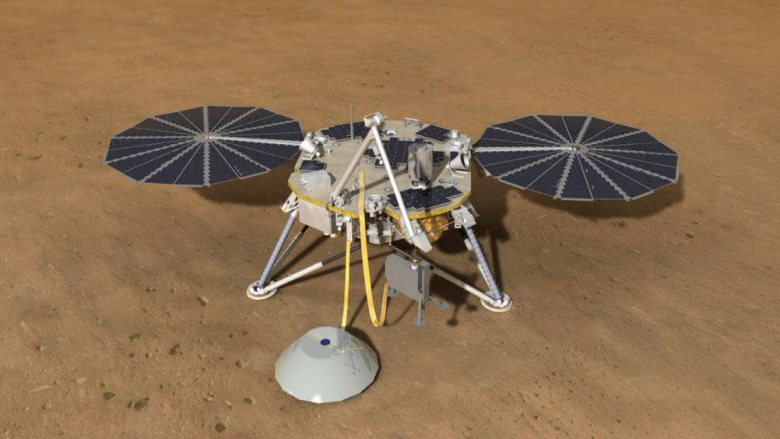SEIS, the French seismometer on InSight, will listen to the heartbeat of Mars
On Thursday 19 April 2018, Jean-Yves Le Gall, President of CNES and Antoine Petit, President of CNRS, presented the InSight mission (INterior exploration using Seismic Investigations, Geodesy and Heat Transport), the 12th mission of the NASA’s Discovery programme, in which the CNES and the DLR (Deutsches Zentrum für Luft- und Raumfahrt), the German Centre for Aeronautics and Astronautics, are participating. Philippe Lognonné, Principal Investigator of the SEIS instrument (Seismic Experiment for Interior Structure) at IPGP (Institut de Physique du Globe de Paris, Université Paris Diderot1, CNRS), Philippe Laudet, SEIS Project Manager at CNES, Francis Rocard, Head of the Solar System Exploration Program at CNES and Franck Poirrier, President of Sodern, SEIS instrument manufacturer, also participated in this sequence. The scientific goal of the InSight mission is to understand how Mars was formed and how it evolved into today’s frozen desert. The launch is scheduled for May 5 aboard an Atlas V launcher from the Vandenberg base in California. The probe will travel six months before arriving on Mars on November 26, 2018.

Using sophisticated geophysical instruments never before used on Mars, InSight will measure seismic activity on the Red Planet. Seismic measurements of SEIS, internal heat flux and subtle variations in the planet’s rotation speed will provide a better understanding of its internal structure. Size and nature of the core, viscosity of the mantle and thickness of the crust: the secrets of Mars’ interior will be unlocked, leading us to learn more about its formation and evolution. Many scientists hypothesize that an Earth-like environment existed on Mars early in its history, before it became a desolate and icy planet for reasons certainly related to its small size. Was Mars, a habitable planet, ever inhabited? This is the big question that justifies its exploration.
The SEIS seismometer is the central instrument of the mission. Its objective is to analyze the “Mars tremors”, meteorite impacts and the tidal effect produced by Phobos, to visualize the interior of Mars. A seismometer has been placed on the surface of the Red Planet for the first time. CNES has developed a dedicated ground segment, the SISMOC (SeIS on Mars Operation Center), which aims to analyze the telemetry from Mars and develop the SEIS remote controls for the duration of the mission. SISMOC will distribute the seismic data to the IPGP for analysis, which will transmit them to scientists around the world. The control centre is located at the Toulouse Space Center.
CNES is the prime contractor for the SEIS seismometer, which is the main instrument of the InSight mission. It finances the French contributions, coordinates the international consortium and is responsible for the integration, testing and supply of the complete instrument to NASA. The IPGP has scientific responsibility for the instrument and is the designer of the wide frequency band (VBB) sensors that are the heart of the seismometer and whose realization has been entrusted to the company Sodern. The high-frequency sensors are supplied by Imperial College London and the University of Oxford in the United Kingdom. The levelling system is provided by the Max Planck Institute for Solar System Research (MPS, Göttingen) in Germany. The electronic box is provided by the Swiss Federal Institute of Technology Zurich (ETHZ) in Switzerland. The Jet Propulsion Laboratory (JPL) in the United States provides the shielded cable connecting the seismometer on the Martian ground to its electronics installed on the lander. JPL also supplies the vacuum-held sphere containing the VBB sensors and the thermal shields protecting the seismometer from temperature variations and wind. The Institut Supérieur de l’Aéronautique et de l’Espace (ISAE) digitally modeled the various noise sources of the instrument and contributed to the SEIS flight software.
In addition to the IPGP, several other CNRS and French university laboratories have been involved in the development of SEIS (Irap2, IMPMC3, Navier4, LMD5) and will participate in the analysis of the data (Laboratoire de Planétologie et Géodynamique de Nantes6, Laboratoire J.L. Lagrange7, …) and in their dissemination for educational purposes such as the Sismo network at school (GéoAzur8).
During this presentation, Jean-Yves Le Gall stated: “Mars is of major interest to the international scientific community. This major first, a seismometer placed on the surface of the Red Planet, is a unique opportunity to learn more about its internal structure. This mission also symbolizes the excellent cooperation between France and the United States. I will meet the entire scientific community on May 5 for takeoff and November 26 for landing in the western part of the Elysium Planitia plain. »
For Antoine Petit, President and CEO of the CNRS, “Almost 50 years after the first seismometer was installed on the Moon by the Apollo XI mission, we are just a few months away from the first seismological measurements on Mars. The unique data from the InSight mission, thanks to an international collaboration involving French research, will enable us to take a major step forward in understanding how Mars works. »
IRAP Contacts
- Raphael Garcia, chercheur à l’ISAE et à l’IRAP : Raphael.GARCIA@isae-supaero.fr
- Thierry Camus, responsable de l’électronique de proximité à l’IRAP






